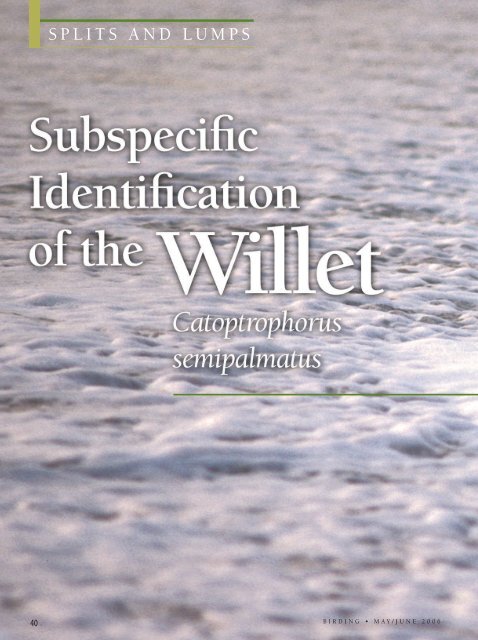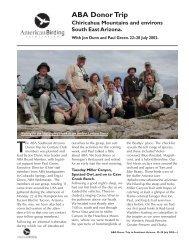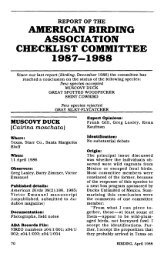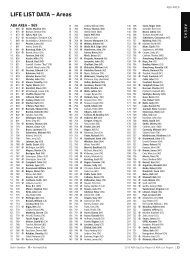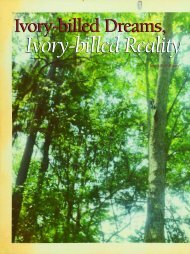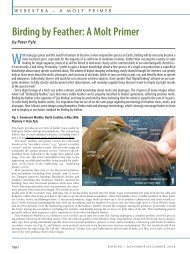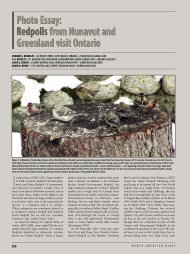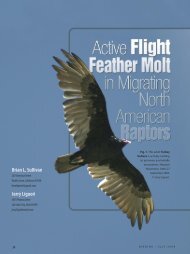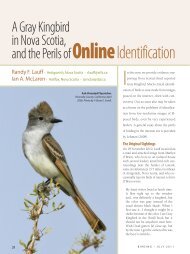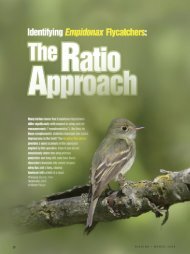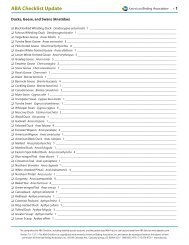Subspecific Identification of the Willet Catoptrophorus semipalmatus ...
Subspecific Identification of the Willet Catoptrophorus semipalmatus ...
Subspecific Identification of the Willet Catoptrophorus semipalmatus ...
- No tags were found...
Create successful ePaper yourself
Turn your PDF publications into a flip-book with our unique Google optimized e-Paper software.
SPLITS AND LUMPS40BIRDING • MAY/JUNE 2006
Fig. 1. Eastern and Western<strong>Willet</strong>s. Can you tell which iswhich? Answer at bottom <strong>of</strong> p. 46.North Carolina; late July 1995.© Michael O’Brien.Michael O’Brien152 Stevens StreetWest Cape May, New Jersey 08204tsweet@comcast.netThe <strong>Willet</strong> is a familiar shorebird to many birdersaround temperate regions <strong>of</strong> North, Central, and SouthAmerica. Its large size, drab plumage, and flashy wingpattern make it relatively straightforward to identify.A more difficult and interesting endeavor isdistinguishing between <strong>the</strong> two subspecies,“Eastern <strong>Willet</strong>” (C. s. <strong>semipalmatus</strong>)and “Western <strong>Willet</strong>” (C. s.inornatus). Morphologically and ecologically,<strong>the</strong>se two populations are distinct andmeet most criteria for separate species.WWW.AMERICANBIRDING.ORG41
W I L L E T SFig. 2. Molting adult Eastern (left) and Western(right) <strong>Willet</strong>s. When Eastern <strong>Willet</strong>s first arrivealong <strong>the</strong> Gulf Coast in March, <strong>the</strong>y <strong>of</strong>ten retain extensivenon-breeding (unpatterned) plumage. Full breedingplumage is usually acquired during April. Note <strong>the</strong>Eastern’s slimmer body, darker, browner overall coloration,and heavier, paler-based bill. Note also thatalthough both populations show a buffy ground colorto <strong>the</strong> breast, that <strong>of</strong> <strong>the</strong> Western contrasts with itsmore neutral gray upperparts. Gulf Coast Eastern <strong>Willet</strong>saverage subtly larger, longer-billed, and palerthan Atlantic Coast breeders; thus, size, bill length,and color differences are sometimes less obvious<strong>the</strong>re. Texas; late March 2004. © Michael O’Brien.Eastern <strong>Willet</strong> is a common and conspicuous breeder insalt marshes and mangroves along <strong>the</strong> Atlantic and GulfCoasts from Newfoundland to Tamaulipas. Isolated populationsalso nest in <strong>the</strong> Bahamas, Greater Antilles, CaymanIslands, and <strong>the</strong> island <strong>of</strong> Los Roques <strong>of</strong>f <strong>the</strong> coast <strong>of</strong>Venezuela. Breeding birds forage primarily in salt marshpools, tidal creeks and flats, beaches, and oyster beds. Dueto identification difficulties, wintering areas are still poorlyknown, but most Eastern <strong>Willet</strong>s apparently winter incoastal eastern South America, particularly in Brazil (Morrisonand Ross 1989, Sick 1993). Some may also winter asfar south as Paraguay and Argentina, and as far north as <strong>the</strong>West Indies and Central America. Eastern <strong>Willet</strong> is undocumentedin <strong>the</strong> United States in winter. Spring migrantsfirst arrive along <strong>the</strong> nor<strong>the</strong>rnGulf Coast in early March (K.Karlson, personal communication)and along <strong>the</strong> AtlanticCoast in early April. Fall migrantsdepart very early, withpeak departure <strong>of</strong> adults inearly–mid July and most goneby early August. Juveniles departby late July or early August,with a few lingering intoSeptember (rarely later).Unlike its salt marsh relative,Western <strong>Willet</strong> breeds in interiorprairies from sou<strong>the</strong>rn Albertaand Manitoba to nor<strong>the</strong>rnCalifornia and Colorado. Breedersand interior migrants forage primarilyin wet pastures, in freshmarshes, and on lake shores. Western<strong>Willet</strong> winters in coastal areas fromWashington and New Jersey south toPeru, <strong>the</strong> West Indies, and nor<strong>the</strong>rnSouth America. Coastal migrants andwintering birds prefer rocky coastlines, sod banks, tidalflats, beaches, and shallow bays, where <strong>the</strong>y <strong>of</strong>ten associatewith Marbled Godwits. They seldom use <strong>the</strong> mucky tidalcreeks frequented by Eastern <strong>Willet</strong>. Spring migrants departfrom coastal wintering areas mostly from mid-April to earlyMay, although a few non-breeders remain on <strong>the</strong> coastthrough <strong>the</strong> summer. Fall migrants return to <strong>the</strong> coast asearly as mid- to late June and are numerous <strong>the</strong>re by earlyto mid-July. Juveniles arrive along <strong>the</strong> coast by mid- to lateJuly and are numerous <strong>the</strong>re by August.Morrison et al. (2001) estimate <strong>the</strong> total population <strong>of</strong><strong>Willet</strong>s at 250,000, with about 160,000 from Pacific and Interiorflyways where only Westerns occur. The remaining90,000 are from <strong>the</strong> Atlantic Coast and o<strong>the</strong>r regions,Fig. 3 (opposite page). Typical silhouettes <strong>of</strong> Eastern (right) and Western (left) <strong>Willet</strong>s while relaxed, walking, andstanding alert. Size is always a good starting point with <strong>Willet</strong> subspecies identification. Westerns average about 10% larger thanEasterns (Sibley 2000) and are about equal in size to Hudsonian Godwit. Easterns rarely appear godwit-sized but instead are closerto <strong>the</strong> size <strong>of</strong> a large Greater Yellowlegs. However, both subspecies show much size variation, with females larger than males. Thisvariation is particularly pronounced in Western, some males <strong>of</strong> which overlap with Eastern in size. Regardless <strong>of</strong> this overlap, typicallysmall male Easterns and typically large female Westerns are very distinctive.Structure is <strong>of</strong>ten <strong>the</strong> most reliable means <strong>of</strong> identification, although a few birds look intermediate. In overall silhouette, Westernslook somewhat more elegant and godwit-like than Easterns, with longer legs and necks, and longer, slimmer, finer-tipped bills(although a few are heavier-billed). Western’s stride is long, and <strong>the</strong> gait is almost awkwardly stiff-legged. The body is slightly moreelongated, with a more graceful curve to <strong>the</strong> back and a relatively wider girth at mid-body. When relaxed, <strong>the</strong> body <strong>of</strong>ten takes on avery rounded look. Because <strong>the</strong> neck is longer than Eastern’s, when drawn in, <strong>the</strong>re is an almost heron-like bulge more obvious inactive poses. The angle from <strong>the</strong> bill to <strong>the</strong> forehead is usually steeper, and <strong>the</strong> crown is sometimes distinctively tall or puffy.Eastern looks subtly more compact, shorter-legged, shorter-necked, and shorter-bodied. Its stride is shorter and its gait quickerand more fluid than Western’s. The body is slimmer than Western’s and takes on more <strong>of</strong> a long oval shape when relaxed. Whenstanding alert, <strong>the</strong> body <strong>of</strong>ten assumes a more-vertical stance and <strong>the</strong> back is <strong>of</strong>ten strikingly flat from <strong>the</strong> shoulders to <strong>the</strong> wingtips. The relatively short neck does not form much <strong>of</strong> a bulge when drawn in. The bill is variable in shape but is usually shorter andstouter than Western’s, with a heavier tip and <strong>of</strong>ten a slight droop or a more pronounced gonydeal angle. Some birds, however,overlap with Western in bill thickness. The angle from <strong>the</strong> bill to <strong>the</strong> forehead is usually shallower on Eastern, and <strong>the</strong> crown is notvery tall, emphasizing <strong>the</strong> heavier bill. Pen-and-ink on paper by © Michael O’Brien.42BIRDING • MAY/JUNE 2006
WWW.AMERICANBIRDING.ORG43
W I L L E T SFig. 4. Juvenile Eastern <strong>Willet</strong> with Laughing Gull. JuvenileEasterns look darker and browner overall, <strong>of</strong>ten with more extensivemottling on <strong>the</strong> breast and flanks. The scapulars are particularlydark, with more contrastingly pale marginal spots and usually morecontrast between <strong>the</strong> darker scapulars and paler coverts. The covertsand tertials tend to be more contrastingly marked than on juvenileWestern. The bill-base averages paler than Western’s, but much variationexists. Note <strong>the</strong> short, heavy bill, relatively short legs, andsmoothly rounded breast with no bulge at <strong>the</strong> base <strong>of</strong> <strong>the</strong> neck.North Carolina; late July 1994. © Michael O’Brien.Fig. 5. Non-breeding Western <strong>Willet</strong>. Note <strong>the</strong> slim, fine-tipped bill; <strong>the</strong> tall, rounded crown; and<strong>the</strong> pale overall coloration. In this relaxed pose, note <strong>the</strong> plump, rounded body shape with a hint <strong>of</strong> abulging neck-base. Non-breeding Eastern differs from Western in structure and in its overall darker,browner coloration. Western <strong>Willet</strong> is a common wintering bird along <strong>the</strong> sou<strong>the</strong>rn coasts <strong>of</strong> <strong>the</strong> U. S.Eastern is undocumented in North America in winter. New Jersey; November 1997. © Michael O’Brien.presumably where both populations occur. Although<strong>the</strong> majority <strong>of</strong> <strong>the</strong>se are likely Easterns,some Westerns (e.g., those migratingalong <strong>the</strong> Atlantic Coast) are surely included,so <strong>the</strong> total population <strong>of</strong> Easterns is probablyless than 90,000.The true taxonomic status <strong>of</strong> Eastern andWestern <strong>Willet</strong>s remains unresolved. Differencesin structure, plumage, molt patterns,and voice are outlined on pp. 45–46. The tw<strong>of</strong>orms breed allopatrically, and I hypo<strong>the</strong>sizethat <strong>the</strong>y have been reproductively isolatedfrom one ano<strong>the</strong>r at least since <strong>the</strong> late Pleistocene.Mitochondrial DNA evidence hasshown Pleistocene glacial events to be responsiblefor both initiation and completion <strong>of</strong> speciationin numerous sister species pairs such44BIRDING • MAY/JUNE 2006
as King and Clapper Rails, Nelson’s and Saltmarsh Sharp-tailed Sparrows, and Greattailedand Boat-tailed Grackles (Johnson and Cicero 2004), species pairs withcoastal vs. interior distribution patterns comparable to those <strong>of</strong> Eastern and Western<strong>Willet</strong>s. Playback experiments have demonstrated that Eastern <strong>Willet</strong>s discriminatebetween <strong>the</strong> songs <strong>of</strong> <strong>the</strong> two subspecies, responding to playback <strong>of</strong> Eastern with an83% frequency and to that <strong>of</strong> Western with a 22% frequency (Douglas 1998). However,a similar discrimination was not found when o<strong>the</strong>r vocalizations were played,and Eastern <strong>Willet</strong>s readily recognized and responded to playback <strong>of</strong> all Western<strong>Willet</strong> calls. A thorough study <strong>of</strong> <strong>Willet</strong> DNA is needed to clarify <strong>the</strong> degree <strong>of</strong> geneticseparation between <strong>the</strong>se two taxa.Fig. 6. Juvenile Western <strong>Willet</strong>. JuvenileWesterns usually look pale and buffy-gray overall.Pale marginal spots and dark subterminalmarkings on <strong>the</strong> scapulars, coverts, and tertialsshow relatively low contrast with <strong>the</strong> rest <strong>of</strong> <strong>the</strong>plumage. The flanks are pale and <strong>of</strong>ten appearmostly white under bright lighting conditions.Note <strong>the</strong> long legs; <strong>the</strong> long, straight, evenlytapered,fine-tipped bill; <strong>the</strong> graceful curve to<strong>the</strong> back; and <strong>the</strong> bulge at <strong>the</strong> base <strong>of</strong> <strong>the</strong> neck.North Carolina; late July 1995. © Michael O’Brien.<strong>Identification</strong>Distinguishing between Eastern and Western <strong>Willet</strong>sis mostly a matter <strong>of</strong> size, structure, and overall color.On average, Westerns are larger, paler, longer- andslimmer-billed, longer-legged, and longer-necked thanEasterns. Each <strong>of</strong> <strong>the</strong>se characters is somewhat variable,however, and a small percentage <strong>of</strong> birds look intermediate.Also, populations <strong>of</strong> Eastern <strong>Willet</strong>s on<strong>the</strong> Gulf Coast look subtly larger, paler, and longerbilled,on average, than Atlantic Coast birds. DespiteFig. 7. Breeding Western <strong>Willet</strong>. Note <strong>the</strong> plump, rounded body; <strong>the</strong> slim,fine-tipped bill; <strong>the</strong> tall, rounded crown; <strong>the</strong> long legs; and <strong>the</strong> pale overall coloration.The ground color <strong>of</strong> <strong>the</strong> upperparts is neutral gray, whereas that <strong>of</strong> <strong>the</strong>breast is pale buff. In April, many birds still hold extensive plain gray upperpartsfrom non-breeding plumage. In spring and early summer, <strong>the</strong> bill <strong>of</strong>tenbecomes distinctively dark. Texas; mid-April 2004. © Michael O’Brien.WWW.AMERICANBIRDING.ORG45
W I L L E T SFig. 8. Breeding Eastern <strong>Willet</strong>. Note <strong>the</strong> slim body, <strong>the</strong> relatively heavy bill, <strong>the</strong>shallow forehead angle, and <strong>the</strong> brownish overall coloration. In spring and summer,<strong>the</strong> bill <strong>of</strong>ten becomes distinctively pinkish-based. Dark markings on <strong>the</strong> upperpartsand breast are usually heavier than on Western. Behavioral clues are particularly helpfulalong <strong>the</strong> Gulf and sou<strong>the</strong>rn Atlantic Coasts in spring, when most Easterns are displayingnoisily over salt marsh territories and when most Westerns are foraging quietlyon beaches. Texas; mid-April 2004. © Michael O’Brien.Fig. 9. Breeding Eastern <strong>Willet</strong>. The relatively short, stout, pinkish-based bill; <strong>the</strong>short legs; <strong>the</strong> shallow forehead angle; <strong>the</strong> slim, compact body; and <strong>the</strong> brownishground color to <strong>the</strong> upperparts are distinctive. The heavily barred underparts are probablyoutside <strong>the</strong> range <strong>of</strong> variation <strong>of</strong> Western, although <strong>the</strong> darkest Westerns may benearly as heavily marked. Bill shape is variable in both subspecies. This individual isnormal but on <strong>the</strong> slim end for Eastern. New Jersey; mid-June 2005. © Michael O’Brien.this variation, a combination <strong>of</strong> characters is distinctive inmost individuals. See Figs. 1–12 for details.Molt patterns differ slightly between <strong>the</strong> two subspecies.From an identification standpoint, <strong>the</strong> most useful differenceis <strong>the</strong> geographic region in which <strong>the</strong> prebasic flightfea<strong>the</strong>rmolt takes place. Both subspecies undergo this molton or near <strong>the</strong> wintering grounds, which, for Western <strong>Willet</strong>,includes <strong>the</strong> sou<strong>the</strong>rn coasts <strong>of</strong> North America. Easternsretain full flight fea<strong>the</strong>rs while in North America. Similarly,Easterns undergo only limited prebasic body moltbefore departure in fall, whereas local wintering Westernsundergo <strong>the</strong>ir entire molt here.Vocalizations <strong>of</strong>ten provide a useful means <strong>of</strong> distinguishingbetween Eastern and Western <strong>Willet</strong>s. Differences in <strong>the</strong>primary “pill will willet” song are particularly distinct. Eastern’ssong is an urgent, rapidly-repeated pidl-will-willit.Western’s is a slower, lower-pitched, more clearly annunciatedp’d-weeel-will-wit with <strong>the</strong> second note more drawnoutand <strong>the</strong> last two notes more clearly separated. With a littlepractice, <strong>the</strong> difference is obvious. In both subspecies,songs are given by both sexes, primarily on <strong>the</strong> breedinggrounds but also occasionally during spring migration. Differencesbetween calls are much less distinct that those betweensongs. All calls <strong>of</strong> Western average lower-pitched andmore drawn-out than those <strong>of</strong> Eastern, but much overlapexists and many calls are not readily identifiable to subspecies.The flight call is a loud, strident klaay-drr or klaaydr-dr,typically with a lower, huskier, Marbled Godwit-likequality in Western and a higher, Laughing Gull-like qualityin Eastern. With practice, classic examples <strong>of</strong> <strong>the</strong>se calls aredistinctive but variation precludes <strong>the</strong> identification <strong>of</strong>some. When flushed, both subspecies utter a higher, moreexcited kli-li-li-li, <strong>of</strong>ten with a trilled quality (on average,more distinctly trilled in Western). The breeding alarm callis a sharp, repeated kleep or kalip, lower and more muffledin Western. The year-round alarm is a more drawn-out,screaming klaayii and variations, <strong>of</strong>ten with a distinctlycurlew-like quality, particularly in Western.AcknowledgmentsMuch <strong>of</strong> <strong>the</strong> information in this article has been adaptedfrom The Shorebird Guide, published by Houghton Mifflinin April 2006. I am grateful to my coauthors, RichardCrossley and Kevin Karlson, for sharing <strong>the</strong>ir thoughts on<strong>Willet</strong> identification. Helpful information or discussionswere also provided by Bob Carlough, Steve Howell, TonyLeukering, Paul O’Brien, and Chris Vogel.Literature CitedDouglas, H.D. 1998. Response <strong>of</strong> Eastern <strong>Willet</strong>s (<strong>Catoptrophorus</strong> s. <strong>semipalmatus</strong>) to vocalizations<strong>of</strong> Eastern and Western (C. s. inornatus) <strong>Willet</strong>s. Auk 115:514–518.Johnson N.K., and C. Cicero. 2004. New mitochondrial DNA data affirm <strong>the</strong> importance <strong>of</strong>Pleistocene speciation in North American birds. Evolution 58:1122–1130.Morrison, R.I.G, R.E. Gill, B.A. Harrington, S. Skagen, G.W. Page, C.L. Gratto-Trevor, and S.M.Haig. 2001. Estimates <strong>of</strong> shorebird populations in North America. Canadian WildlifeService Occasional Paper no. 104. Environment Canada, Ottawa.Morrison, R.I.G., and R.K. Ross. 1989. Atlas <strong>of</strong> Nearctic Shorebirds on <strong>the</strong> Coast <strong>of</strong> SouthAmerica, vol. 1. Canadian Wildlife Service Special Publication, Ottawa.Sibley, D.A. 2000. The Sibley Guide to Birds. Alfred A. Knopf, New York.Sick, H. 1993. Birds in Brazil: A Natural History. Princeton University Press, Princeton.46ANSWER: The front bird in Fig. 1 is a Western <strong>Willet</strong>, and <strong>the</strong>rear bird is an Eastern.
Fig. 10 (above). Juvenile/non-breeding Western (left) and Eastern (right) <strong>Willet</strong>s. Inflight, Eastern looks more compact, with a shorter body, with slightly narrower, <strong>of</strong>ten more angledwings, and with quicker wingbeats. Western looks somewhat more elongated, with adeep-keeled or heavy-chested look. Although <strong>the</strong> legs are longer in Western, foot projection isabout <strong>the</strong> same due to its longer body. As on standing birds, bill shape is one <strong>of</strong> <strong>the</strong> best clues.Eastern is darker and browner overall and <strong>of</strong>ten has more-extensive dark mottling along <strong>the</strong>flanks. Western looks paler and grayer overall, with paler upperwing coverts and <strong>of</strong>ten whiterlookingflanks that contrast more with <strong>the</strong> black wing markings. Both subspecies show greatvariation in wing-stripe thickness, to <strong>the</strong> point that variation in Eastern is completely overlappedby variation in Western. However, Western’s wing stripe averages broader, and manyWesterns show distinctively broad wing stripes. Pen-and-ink on paper by © Michael O’Brien.Fig. 11 (right). Worn breeding Western <strong>Willet</strong>. The slim, fine-tipped, relatively dark bill;<strong>the</strong> long legs; and <strong>the</strong> long neck are distinctive. Birds in mid-summer show heavier markings,<strong>of</strong>ten approaching Eastern. Note <strong>the</strong> pale, neutral gray ground color to <strong>the</strong> upperparts, contrastingstrongly with <strong>the</strong> barring and subtly with <strong>the</strong> buff ground color to <strong>the</strong> breast. Barringon <strong>the</strong> underparts averages thinner, sparser, and paler than on Eastern, although <strong>the</strong> breastspotting is <strong>of</strong>ten more pronounced. North Carolina; early July 2005. © Michael O’Brien.Fig. 12 (below). Mostly non-breeding Western <strong>Willet</strong> (left) with worn breeding Eastern<strong>Willet</strong>s. This Western looks distinctively pale, largely because it has already acquired extensivenon-breeding plumage. It may be an early molting adult but, at this early date, is more likely afirst-summer (one-year-old) bird that never acquired full breeding plumage. Such birds <strong>of</strong>tenspend <strong>the</strong> summer in coastal areas, where <strong>the</strong>y look strikingly paler than <strong>the</strong> local breeding Easterns.Easterns usually hold most <strong>of</strong> <strong>the</strong>ir breeding plumage until <strong>the</strong> wintering grounds arereached. It should be emphasized that Easterns in full non-breeding plumage (including first-summerplumage) are undocumented in <strong>the</strong> U. S. North Carolina; early July 1998. © Michael O’Brien.WWW.AMERICANBIRDING.ORG47


